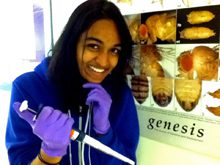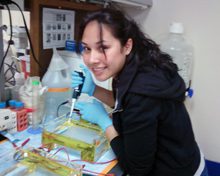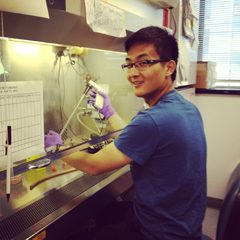John Campo

The ultimate goal of my research is to identify the structure of the subunit of DNA polymerase III in Aquifex aeolicus (Aquifex) using X-ray crystallography. DNA pol III is the enzyme that is responsible for the majority of the DNA replication that occurs in this strain of bacteria. The the subunit of DNA pol III is responsible for the polymerase activity. To date, the structure of the replicative unit has only been determined in two gram-negative bacteria, Escherichia coli (E. coli) and Thermus aquaticus (Taq) (Lamers et al., 2006, and […]
Sivapratha Nagappan Chettiar

Neurogenesis, the production of new neurons, occurs via the asymmetrical division of neural stem cells in specific regions of the mammalian and Drosophila brain. It is a highly regulated process as proper neuron type and number is crucial to allow the proper formation and functioning of the brain. In Drosophila brain, much is known about the pathways that regulate asymmetric cell division. However, little is known about the mechanisms that regulate its termination. In PTEN tumor suppressor gene mutants, neural stem cells aberrantly persist in the brain of adult Drosophila. […]
Elina Serrano

KCNK18 is a two-pore potassium channel that is hypothesized to play a key role in pain and touch. Mutations in the KCNK18 gene have been found in people suffering from familiar migraine. Furthermore, this channel is targeted by a variety of anesthetics as well as hydroxy–sanshool, the active ingredient in Szechuan peppercorn responsible for its tingling and numbing analgesic properties. Since the parts of the protein responsible for function and modulation of the channel have not been identified, the specific goal of my project is to create and screen a […]
Xinkang Wang

This project aims at providing constraints on the dark energy parameters through galaxy surveys. In theory, given the precise values of cosmological parameters, including the dark energy parameters (e.g., the density parameter ), we are able to determine the history and the ultimate fate of the universe.Therefore, to better understand the evolution of the universe and to improve current related theories in physics, we need to determine the values of dark energy parameters with higher precision to put in another way, we need to put further constraints on the parameters. […]
Yechong Yu

My current project is about reading performance across different methods of text presentation. The standard form of text presentation is by printed words on a page or screen in blocks of sentences and paragraphs. This way of text presentation is difficult for people who have diseases of the eye that hinder eye movement. One way to correct this problem is through rapid serial visual presentation, or RSVP, where text is presented one word at a time in sequence on a monitor. Do reading speed and comprehension improve when this method […]
Alexandra Carstensen

How does the brain represent concepts outside of perceptual experience? Relatively little is known about the neural mechanisms and brain areas involved in abstract thoughtthose enabling us to conceptualize domains for which we lack dedicated perceptual systems. Theories of embodied cognition suggest that understandings of such abstract domains are constructed from co-experienced perceptual input; for instance, Lakoff & Johnson (1999) have proposed that we build representations of time based on experiences of movement through space, as we consistently experience the passage of time while moving. This research seeks to determine […]
Dayoung Park

Degradation reactions of alkyl radicals are of interest in combustion chemistry, planetary atmospheres, and the interstellar medium. However, the nature of their reaction pathways is not easily understood as the intermediates are highly reactive. My project will investigate the dissociation dynamics of a simple primary alkyl radical, 1-propyl, upon excitation at 248 nm using a detection scheme known as photofragment translational spectroscopy. Four distinctive product channels are assessed at this wavelength. A preliminary experimental work seems to indicate that the C-C bond cleavage is energetically the most favorable product channel. […]
Jae Young Ryoo

Clathrin-mediated endocytosis is a process by which a cell absorbs molecules with the help of the protein clathrin. Cell biology studies often employ a variety of different cell types to study a single cellular pathway but how these pathways operate often differ depending on the cell type observed. Unfortunately, in most cases, little is known about the mechanisms that give rise to these differences. I aim to explore how cells differ in the process of clathrin-mediated endocytosis, with the ultimate goal of understanding why these differences exist and what it […]
Hoiyi Ng

Although Random Matrix Theory has been developed for almost a century, its application in finance is underutilized. A random matrix is a Hermitian matrix with its entries drawn from a normal distribution with mean zero and variance one. Most of its interesting properties lie in the distribution of its eigenvalues. Not until recently has RMT been employed to estimate the profits and risks of financial portfolios. My project focuses on exploring new ways to manipulate current methods frequently adopted to maximize the profit of a financial portfolio given a certain […]
Rebecca Yue

Salmonella enterica is a bacterium that causes major food borne disease in the world. It infects people by inducing the uptake of the bacteria by secreting proteins into cells in the host’s intestines. A crucial system of Salmonella enterica pathogenesis is the Type III Secretion System (T3SS) which transports bacterial proteins into host cells. Previous experiments indicate that the Disulfide Bond Formation (Dsb) System is needed for the Type III Secretion System. However, a direct interaction between the two systems is not currently known. Through molecular cloning and a bacterial […]